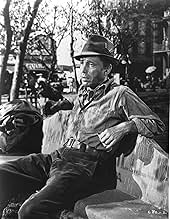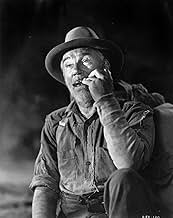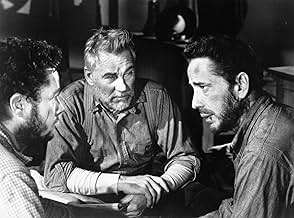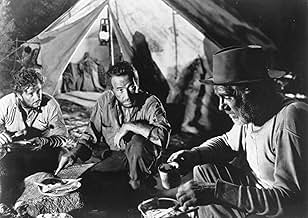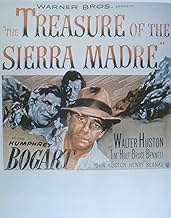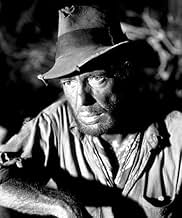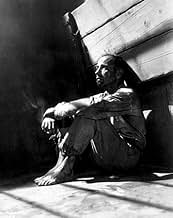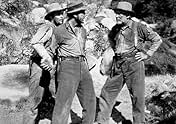Deux Américains à la recherche d'un emploi au Mexique convainquent un ancien prospecteur de les aider à chercher de l'or dans les montagnes de la Sierra Madre.Deux Américains à la recherche d'un emploi au Mexique convainquent un ancien prospecteur de les aider à chercher de l'or dans les montagnes de la Sierra Madre.Deux Américains à la recherche d'un emploi au Mexique convainquent un ancien prospecteur de les aider à chercher de l'or dans les montagnes de la Sierra Madre.
- A remporté 3 oscars
- 18 victoires et 5 nominations au total
Barton MacLane
- Pat McCormick
- (as Barton Mac Lane)
Arturo Soto Rangel
- Presidente
- (as A. Soto Rangel)
Manuel Dondé
- El Jefe
- (as Manuel Donde)
José Torvay
- Pablo
- (as Jose Torvay)
Robert Blake
- Mexican Boy Selling Lottery Tickets
- (uncredited)
Guillermo Calles
- Mexican Storeowner
- (uncredited)
Roberto Cañedo
- Mexican Lieutenant
- (uncredited)
Spencer Chan
- Proprietor
- (uncredited)
Jacqueline Dalya
- Flashy Girl
- (uncredited)
Ralph Dunn
- Flophouse Bum
- (uncredited)
Ernesto Escoto
- Mexican Bandit
- (uncredited)
Sommaire
Reviewers say 'The Treasure of the Sierra Madre' is a critically acclaimed classic, lauded for its profound examination of greed, betrayal, and human nature. John Huston's direction and screenplay, alongside exceptional performances by Humphrey Bogart, Walter Huston, and Tim Holt, are often celebrated. The film's authentic atmosphere, intricate character studies, and moral complexities deeply resonate. Although some critique its pacing and subplots, most regard it as a timeless masterpiece noted for its psychological depth and thematic richness.
Avis en vedette
Film noir takes a Mexican holiday in this gritty adventure from John Huston. Pessimistic and full of irony, yet with a sense of adventure and a moralist edge to it, this is typical Huston material.
Huston insisted on shooting on location in Mexico, which riled up studio executives no end, but it paid off in the quality of the picture. Treasure of the Sierra Madre would have really suffered in the canned air of a studio. By using the real thing, he perfectly achieves the stark and dusty atmosphere of the poverty riddled Mexican city in the earliest scenes. The sense of scale and grandeur of the mountains in the main part of the film is also very important in achieving the right effect.
Huston's background was in fine art, and it's at this point in his career as a director that it really starts to show. The use of lighting is painterly in a way that is almost impossible to achieve in black and white particularly in the scene in the peasant village which looks almost biblical. Huston also has this unique style of framing, whereby he uses figures in the foreground and background to give the effect of a close-up and a mid-shot simultaneously. It's a look that is totally at odds with anything else produced in Hollywood at that time.
Actor wise, Treasure of the Sierra Madre turns the clock back to the 1930s, putting the director's father Walter Huston in a starring role, and casting Humphrey Bogart as a seedy villain. The cast is rounded off by the too-little-seen Tim Holt. All three of them are spot on. The spry old prospector is a role Huston senior seems to have been waiting to play all his life. Bogart is also great playing the sort of character he made his name with a decade earlier. Also worth a mention is Mexican actor Alfonso Bedoya who gives what is for this era an incredibly naturalistic performance as the bandit leader.
Huston's forte was in his cinematography, his shot composition and the rhythm of his films, not so much in his handling of action or actors, which is why his pictures tend to be a bit hit and miss. This one is a hit though, thanks to the strength of its story and the quality of the cast, not to mention Huston's persistence for authenticity. Not my absolute favourite of his work, but certainly one of the best.
Huston insisted on shooting on location in Mexico, which riled up studio executives no end, but it paid off in the quality of the picture. Treasure of the Sierra Madre would have really suffered in the canned air of a studio. By using the real thing, he perfectly achieves the stark and dusty atmosphere of the poverty riddled Mexican city in the earliest scenes. The sense of scale and grandeur of the mountains in the main part of the film is also very important in achieving the right effect.
Huston's background was in fine art, and it's at this point in his career as a director that it really starts to show. The use of lighting is painterly in a way that is almost impossible to achieve in black and white particularly in the scene in the peasant village which looks almost biblical. Huston also has this unique style of framing, whereby he uses figures in the foreground and background to give the effect of a close-up and a mid-shot simultaneously. It's a look that is totally at odds with anything else produced in Hollywood at that time.
Actor wise, Treasure of the Sierra Madre turns the clock back to the 1930s, putting the director's father Walter Huston in a starring role, and casting Humphrey Bogart as a seedy villain. The cast is rounded off by the too-little-seen Tim Holt. All three of them are spot on. The spry old prospector is a role Huston senior seems to have been waiting to play all his life. Bogart is also great playing the sort of character he made his name with a decade earlier. Also worth a mention is Mexican actor Alfonso Bedoya who gives what is for this era an incredibly naturalistic performance as the bandit leader.
Huston's forte was in his cinematography, his shot composition and the rhythm of his films, not so much in his handling of action or actors, which is why his pictures tend to be a bit hit and miss. This one is a hit though, thanks to the strength of its story and the quality of the cast, not to mention Huston's persistence for authenticity. Not my absolute favourite of his work, but certainly one of the best.
Some movies have certain scenes in them that hold the viewers interest more than others. However every single scene in this film holds the viewers interest. There is never a dull or lagging moment. Three down and outers who at one time in their lives were maybe up and comers strike out in search of a fortune or at least enough to live better than they have been.
While Humphrey Bogart gives a superb performance it is Walter Huston who turns in the greatest performance as the old prospector Howard. The scene in the Indian village where he helps to restore a comatose child is one of the most touching in all of film history and is done virtually without any dialog. Mexican character actor Alfonso Bedoya of course steals all the scenes he appears in and delivers his classic "Stinking Badges" line. (what person would dress up as a Bandito for a costume party and not want to look exactly like Bedoya's Gold Hat character?) This film probably should have been a little higher on AFI's top 100. A must see!
While Humphrey Bogart gives a superb performance it is Walter Huston who turns in the greatest performance as the old prospector Howard. The scene in the Indian village where he helps to restore a comatose child is one of the most touching in all of film history and is done virtually without any dialog. Mexican character actor Alfonso Bedoya of course steals all the scenes he appears in and delivers his classic "Stinking Badges" line. (what person would dress up as a Bandito for a costume party and not want to look exactly like Bedoya's Gold Hat character?) This film probably should have been a little higher on AFI's top 100. A must see!
Tampico sets the scene for the start of speculation, Fred C. Dobbs is out of cash and his luck is in cessation, but an encounter in flophouse, and big dreams emerge and arouse, as a plan is born with Howard, and a fellow who's called Curtin. Into hills laden with gold, our companions then embark, finding seams that come alive with golden riches to impart, building up substantial fortune, thinking soon they will be tycoons, but there's one who's trust is waning and has sores that start to smart. The journey back becomes a challenge to them all, as one by one the group is scattered, battered, stalled, will their work be well rewarded, will endeavours all be thwarted, either way, you will be engaged, and quite possibly enthralled.
Bogarts best performance.
Bogarts best performance.
Magnificent rendition of B. Traven's story of ambition and human nature at its worst and dealing with an unlikely trio of ambitious prospectors . As Fred Dobbs (Humphrey Bogart) and Bob Curtin (Tim Holt) , two Americans searching for work in Mexico, convince an old prospector (Walter Huston) to help them mine for gold in the Sierra Madre Mountains . Through a lot of troubles they eventually succeed in finding gold, but greedy outlaws (Alfonso Bedoya) , and most especially craziness lead to disaster . As they sold their souls for the treasure of the Sierra Madre .
It's an intelligent semi-western that scrutinizes the greed and paranoia that afflicts a misfit group , including their enormous difficulties and breathtaking taking on between protagonists and the Mexican enemies that stalk to them . The film blends thrills , emotion , intrigue , high body-count and it's fast moving and exciting ; being filmed in Mexico, though Warners' studio head Jack L. Warner had the unit return to Hollywood when the budget started to exceed $3 million . Thought-provoking screenplay by the same Huston , concerning about greed and ambition that threaten to turn their success into disaster . Director John Huston had read the book by B. Traven in 1936 and had always thought the material would make a great movie . Based on a 19th-century ballad by a German poet , Traven's book reminded Huston of his own adventures in the Mexican cavalry . When Huston became a director at Warner Bros. , the smashing success of his initial effort, The Maltese Falcon (1941), gave him the clout to ask to write and direct the project, for which Warner Bros had previously secured the movie rights . Although by many to be director John Huston's finest film , this is a tale of fear , greed and murder , as three partners fall out over the gold they have clawed out of the inhospitable and bandit-ridden deserts and mountains . It also has probably the most brutal gold bar fight ever put on film along with "The Ruthless Four" . Overrated by some reviewers , but very interesting and attractive to watch . It above all things mostly also remains a real characters movie, in which the three main roles are the essentials . Their dynamic together is also great and is what mostly keeps this movie going . They are three totally different characters, which is the foremost reason why they work out so great together on film . Bogart is superbly believable and gives a nice portrait of an increasingly unhinged prospector , Walter Huston is very good as a cunning veteran and Tim Holt is also pretty well . John Huston has a cameo as an American tourist , this scene was directed by Humphrey Bogart, who took malicious pleasure on his director by making him perform the scene over and over again. And the little boy who sells Bogart the portion of the winning lottery ticket is Robert Blake . The bum seated near Walter Huston in the first scene in the Oso Negro flophouse is Jack Holt, father of Tim Holt . Walter Huston, father of director John Huston, won the Academy Award for best supporting actor , John won for best direction . This was the first father/son win .
The musician Max Steiner composes a vibrant soundtrack and well conducted ; including a catching leitmotif and considered to be one of the best . Atmospheric scenario with barren outdoors , dirty landscapes under sunny exteriors and a glimmer sun and fine sets with striking cinematography by Ted McCord , this was one of the first American films to be made almost entirely on location outside the USA . Also shown in computer-colored version . The picture was shot on location in Tampico, Mexico ; just as John Huston was starting to shoot scenes in, the production was shut down inexplicably by the local government ; it turns out that a local newspaper printed a false story that accused the filmmakers of making a production that was unflattering to Mexico . Fortunately, two of Huston's associates, Diego Rivera and Miguel Covarrubias, went to bat for the director with the President of Mexico , then the libelous accusations were dropped . The motion picture was stunningly realized by John Huston and the film took 5-1/2 months to shoot and was 29 days over schedule ; Robert Rossen submitted at least nine drafts of rewrites on the screenplay when John Huston was away during the war . Rating : Above average . Well worth watching , essential and indispensable seeing . In 2007: The American Film Institute ranked this as the #38 Greatest Movie of All Time.
It's an intelligent semi-western that scrutinizes the greed and paranoia that afflicts a misfit group , including their enormous difficulties and breathtaking taking on between protagonists and the Mexican enemies that stalk to them . The film blends thrills , emotion , intrigue , high body-count and it's fast moving and exciting ; being filmed in Mexico, though Warners' studio head Jack L. Warner had the unit return to Hollywood when the budget started to exceed $3 million . Thought-provoking screenplay by the same Huston , concerning about greed and ambition that threaten to turn their success into disaster . Director John Huston had read the book by B. Traven in 1936 and had always thought the material would make a great movie . Based on a 19th-century ballad by a German poet , Traven's book reminded Huston of his own adventures in the Mexican cavalry . When Huston became a director at Warner Bros. , the smashing success of his initial effort, The Maltese Falcon (1941), gave him the clout to ask to write and direct the project, for which Warner Bros had previously secured the movie rights . Although by many to be director John Huston's finest film , this is a tale of fear , greed and murder , as three partners fall out over the gold they have clawed out of the inhospitable and bandit-ridden deserts and mountains . It also has probably the most brutal gold bar fight ever put on film along with "The Ruthless Four" . Overrated by some reviewers , but very interesting and attractive to watch . It above all things mostly also remains a real characters movie, in which the three main roles are the essentials . Their dynamic together is also great and is what mostly keeps this movie going . They are three totally different characters, which is the foremost reason why they work out so great together on film . Bogart is superbly believable and gives a nice portrait of an increasingly unhinged prospector , Walter Huston is very good as a cunning veteran and Tim Holt is also pretty well . John Huston has a cameo as an American tourist , this scene was directed by Humphrey Bogart, who took malicious pleasure on his director by making him perform the scene over and over again. And the little boy who sells Bogart the portion of the winning lottery ticket is Robert Blake . The bum seated near Walter Huston in the first scene in the Oso Negro flophouse is Jack Holt, father of Tim Holt . Walter Huston, father of director John Huston, won the Academy Award for best supporting actor , John won for best direction . This was the first father/son win .
The musician Max Steiner composes a vibrant soundtrack and well conducted ; including a catching leitmotif and considered to be one of the best . Atmospheric scenario with barren outdoors , dirty landscapes under sunny exteriors and a glimmer sun and fine sets with striking cinematography by Ted McCord , this was one of the first American films to be made almost entirely on location outside the USA . Also shown in computer-colored version . The picture was shot on location in Tampico, Mexico ; just as John Huston was starting to shoot scenes in, the production was shut down inexplicably by the local government ; it turns out that a local newspaper printed a false story that accused the filmmakers of making a production that was unflattering to Mexico . Fortunately, two of Huston's associates, Diego Rivera and Miguel Covarrubias, went to bat for the director with the President of Mexico , then the libelous accusations were dropped . The motion picture was stunningly realized by John Huston and the film took 5-1/2 months to shoot and was 29 days over schedule ; Robert Rossen submitted at least nine drafts of rewrites on the screenplay when John Huston was away during the war . Rating : Above average . Well worth watching , essential and indispensable seeing . In 2007: The American Film Institute ranked this as the #38 Greatest Movie of All Time.
Two penniless Americans (Humphrey Bogart and Tim Holt) during the 1920s in Mexico join with an old-timer (Walter Huston, the director's father) to prospect for gold. The old-timer accurately predicts trouble, but is willing to go anyway. The film is fictional, but presents a very realistic scenario: By the 1920s the violence of the Mexican Revolution had largely subsided, although scattered gangs of bandits continued to terrorize the countryside. The newly established post-revolution government relied on the effective, but ruthless, Federal Police, commonly known as the Federales, to patrol remote areas and dispose of the bandits. Foreigners, like the three American prospectors, were at very real risk of being killed by the bandits if their paths crossed. The bandits, likewise, were given little more than a "last cigarette" by the army units after capture, even having to dig their own graves first.
The film shows the Americans doing just about anything for money: drilling oil, digging for gold, begging and more. And once gold comes into the picture, the men who once claimed they were not greedy see things differently. Bogart actually goes mad, after he gets greedy and paranoid... during which he encounters a gila monster! The most memorable scene of this film involves the bandits, who don't need any "stinking badges". While the line is much more quotable in "Blazing Saddles", we couldn't have "Blazing Saddles" (or "UHF") without this film... just about everyone, even those who never saw or heard of "Sierra Madre", knows the badges line.
Humphrey Bogart's best film is probably "Casablanca", but this one features him in a nice, rough exterior. Yes, sometimes leading men have beards and are covered in dirt. Pretty boys do not stay pretty boys after digging in the hills, or at least that wouldn't be realistic. This film does a fine job trying to "keep it real", so we have to commend Huston not only on his directing, but his wonderful location scouting.
The film shows the Americans doing just about anything for money: drilling oil, digging for gold, begging and more. And once gold comes into the picture, the men who once claimed they were not greedy see things differently. Bogart actually goes mad, after he gets greedy and paranoid... during which he encounters a gila monster! The most memorable scene of this film involves the bandits, who don't need any "stinking badges". While the line is much more quotable in "Blazing Saddles", we couldn't have "Blazing Saddles" (or "UHF") without this film... just about everyone, even those who never saw or heard of "Sierra Madre", knows the badges line.
Humphrey Bogart's best film is probably "Casablanca", but this one features him in a nice, rough exterior. Yes, sometimes leading men have beards and are covered in dirt. Pretty boys do not stay pretty boys after digging in the hills, or at least that wouldn't be realistic. This film does a fine job trying to "keep it real", so we have to commend Huston not only on his directing, but his wonderful location scouting.
Le saviez-vous
- AnecdotesJohn Huston stated that working with his father on this picture and his dad's subsequent Oscar win were among the favorite moments of his life.
- GaffesAlthough set in the 1920s, many of the cars on the streets of Tampico are of 1930s and 1940s vintage; likewise, women, when prominently seen, are groomed and dressed strictly in the style of the 1940s.
- ConnexionsFeatured in The Screen Writer (1950)
- Bandes originalesBelieve Me If All Those Endearing Young Charms
(1808) (uncredited)
Music traditional
Played on harmonica by Walter Huston
Meilleurs choix
Connectez-vous pour évaluer et surveiller les recommandations personnalisées
Détails
- Date de sortie
- Pays d’origine
- Langues
- Aussi connu sous le nom de
- The Treasure of the Sierra Madre
- Lieux de tournage
- Kernville, Californie, États-Unis(Kelly's Rainbow Mine)
- société de production
- Consultez plus de crédits d'entreprise sur IMDbPro
Box-office
- Budget
- 3 000 000 $ US (estimation)
- Brut – États-Unis et Canada
- 5 014 000 $ US
- Fin de semaine d'ouverture – États-Unis et Canada
- 144 074 $ US
- 14 janv. 2018
- Brut – à l'échelle mondiale
- 5 014 124 $ US
- Durée
- 2h 6m(126 min)
- Couleur
- Rapport de forme
- 1.37 : 1
Contribuer à cette page
Suggérer une modification ou ajouter du contenu manquant


